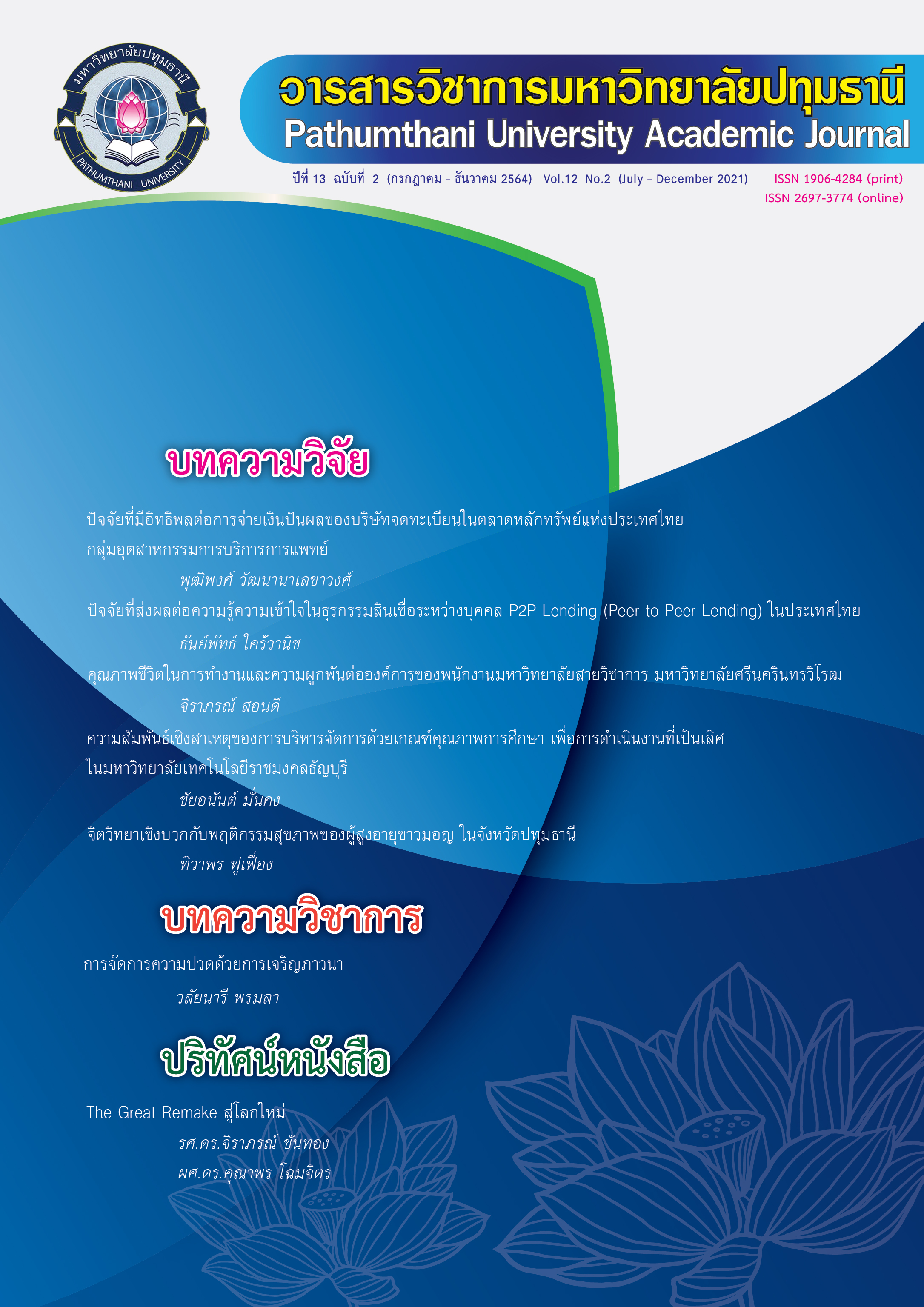EVALUATION OF THE STUDENT MOBILITY PROGRAM: FACULTY OF ISLAMIC SCIENCE, PRINCE OF SONGKLA UNIVERSITY, PATTANI CAMPUS
Keywords:
Evaluation, Student mobilityAbstract
This evaluation research aimed to evaluate student mobility project of faculty of Islamic Sciences. Stufflebeam’s CIPP Model was utilized in the project. The data were collected from 181 students who participated in the project, 8 students who were participating in mobility project in universities abroad, and 2 lecturers at overseas universities. The samples of the study were randomly selected using simple sampling technique. The instrument was constructed by researchers. The content validity of measurement instrument was evaluated by the experts and reliability was calculated using Cronbach’s alpha. Data including frequency, percentage, mean and standard deviation were analyzed. The qualitative data were collected via focus group and in-depth interviews and were analyzed by content analysis.
The result indicated that project input had high level ( =3.97, S.D.=.81). For process of the project, students indicated high level for the project process ( =4.19, S.D.=.82), and the highest level the project product ( =4.54, S.D.=.77). Students indicated a high level for the problems in project participation ( =3.56, S.D.=.53). The qualitative data found the main reasons for students who were interested in participating in the project were their strong desire to: 1) develop advanced language skills, 2) be equipped with good experience abroad and 3) learn more about foreign culture. In addition, lecturers aboard reported that the students participating in the program were highly active in the activities and could well adapt to foreign friends; however, there was a problem for some students who were unable to communicate in Bahasa Melayu.
References
กาญจนา วัธนสุนทร. (2551). “การประยุกต์ใช้รูปแบบการประเมิน CIPP ของสตัฟเฟิลบีม ในการประเมินโครงการทางการศึกษา”. Suranaree Journal of Social Science. ปีที่ 2 ฉบับที่ 1. หน้า 67-83.
กุลธิดา สิงห์สี. (2557). “อุดมศึกษาไทยในอาเซียน รูปแบบ แนวโน้ม และทิศทางการปรับตัวในอนาคต”. วารสารมหาวิทยาลัยราชภัฏลำปาง. ปีที่ 2 ฉบับที่ 2. หน้า 13-23.
เชาว์ อินใย. (2555). การประเมินโครงการ. (พิมพ์ครั้งที่ 2). กรุงเทพมหานคร : จุฬาลงกรณ์มหาวิทยาลัย.
นิดา ลาภศรีสวัสดิ์ และ Fumiyasu Maeno. (2555). “การพัฒนาทักษะการเรียนรู้จากประสบการณ์จริง ของนักศึกษาระหว่างสถาบันเทคโนโลยีพระจอมเกล้าเจ้าคุณทหารลาดกระบังกับมหาวิทยาลัยในประเทศญี่ปุ่น”. เอกสารการประชุมวิชาการทางการศึกษา ระดับชาติ ครั้งที่ 2.
นิศาชล รัตนมณี และ ประสพชัย พสุนนท์. (2562). “อัตราการตอบกลับของแบบสอบถามในการวิจัยเชิงปริมาณ”. Journal of Humanities and Social Sciences Thonburi University. Vol. 13 No. 3 (September – December). หน้า 181-188.
บุญใจ ศรีสถิตนรากูล. (2550). ระเบียบวิธีการวิจัย: แนวทางปฏิบัติสู่ความสำเร็จ. กรุงเทพมหานคร : ยู แอนด์ ไอ อินเตอร์มีเดีย.
พรสันต์ เลิศวิทยาวิวัฒน์. (2562). “ประเมินความพึงพอใจของผู้เข้าร่วมโครงการที่มีต่อโครงการแลกเปลี่ยนวัฒธรรมและการเรียนรู้ไทย-สิงคโปร์ โรงเรียนมัธยมศาสตร์ จังหวัดลำปาง”. วารสารวิชาการมหาวิทยาลัยฟาร์อีสเทอร์น. ปีที่ 13 ฉบับที่ 3. (กรกฏาคม-กันยายน 2562). หน้า 26-38.
พวงรัตน์ ทวีรัตน์. (2540). วิธีการวิจัยทางพฤติกรรมศาสตร์และสังคมศาสตร์. (พิมพ์ครั้งที่ 7). กรุงเทพมหานคร : จุฬาลงกรณ์มหาวิทยาลัย.
รัตนะ บัวสนธ์. (2556). วิธีการเชิงผสมผสานสำหรับการวิจัยและการประเมิน. (พิมพ์ครั้งที่ 2)กรุงเทพมหานคร : สำนักพิมพ์แห่งจุฬาลงกรณ์มหาวิทยาลัย.
วิทยาลัยอิสลามศึกษา. (2560). รายงานการประเมินตนเองตามเกณฑ์คุณภาพการศึกษาเพื่อการดำเนินการที่เป็นเลิศ (Ed PEx) วิทยาลัยอิสลามศึกษา ประจำปีการศึกษา 2559. วิทยาลัยอิสลามศึกษา.
ศิริชัย กาญจนวาสี ทวีวัฒน์ ปิตยานนท์ และดิเรก ศรีสุโข (2555). การเลือกใช้สถิติที่เหมาะสม สำหรับการวิจัย (พิมพ์ครั้งที่ 6). กรุงเทพมหานคร : จุฬาลงกรณ์มหาวิทยาลัย.
Altbach, P.G. & Ebgberg, D. (2014). “Global Student Mobility: The Changing Landscape”. International Higher Education Journal. Vol 77, Pp 11-13.
Kehm, B. M. (2005). “The Contribution of International Student Mobility to Human Development and Global Understanding”. Journal of US-China Education Review. Vol 2 No. 1. pp 18-24.
Konevas, L., & Duoba, K. (2007). “The role of student mobility in the development of human Capital in Europe”. Journal of Economic and Management. Vol 12. Pp 585 -591.
Mechtenberg, L., & Strausz, R. (2008). “The Bologna process: how student mobility affects multi-Cultural skills and educational quality”. International Journal Tax Public Finance. Vol 15. pp 109-130.
Nunnally,J. C. (1978). Psychometric Theory (2nd ed.). New York, NY: McGraw-Hill.
Sekaran, U., & Bougie, R. (2013). Research method for business: A skill-building approach. (6thed). John Wiley & Sons Ltd.
Downloads
Published
How to Cite
Issue
Section
License
บทความที่ได้รับการตีพิมพ์เป็นลิขสิทธิ์ของวารสารมหาวิทยาลัยปทุมธานี
ข้อความที่ปรากฎในบทความแต่ละเรื่อง เป็นความคิดเห็นส่วนตัวของผู้เขียน กองบรรณาธิการไม่จำเป็นต้องเห็นด้วยเสมอไป และไม่มีส่วนรับผิดชอบใด ๆ ถือเป็นความรับผิดชอบของผู้เขียนแต่เพียงผู้เดียว



